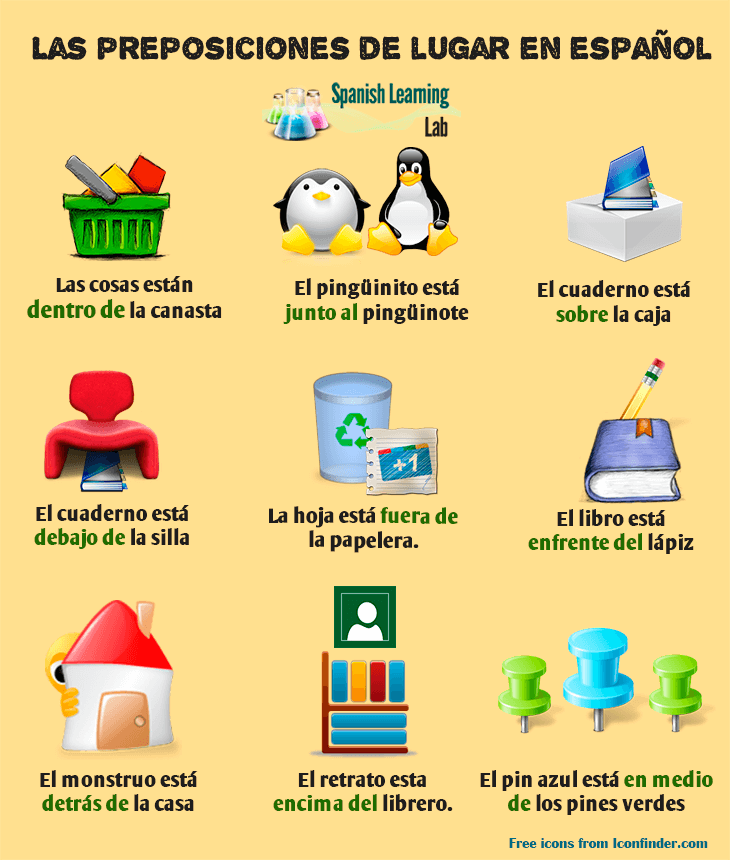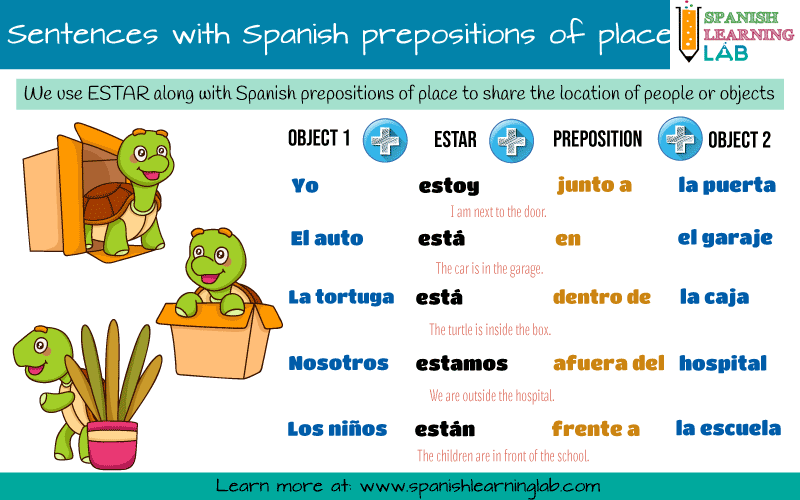Prepositions of place in Spanish, LAS PREPOSICIONES DE LUGAR, are words like “Sobre” (on) and “Debajo” (under) that are normally used to indicate the location of one object in relation to another. In this lesson, we will learn how to use these prepositions together with the verb ESTAR to form basic sentences. In addition, you will be able to practice with the exercises in two interactive quizzes. Let’s start…
Vocabulary introduction: A list of prepositions of place in Spanish
Prepositions are really important and often have many uses in the language. One of the common uses when learning Spanish is to use prepositions of place to say where classroom objects are located, as in the sentences:
- “El escritorio está frente a la pizarra” (the desk is in front of the board).
- “Los lapiceros están sobre la mesa” (The pens are on the table)
In addition, prepositions of place in Spanish can also be used for other purposes such as giving directions, as in the sentence “El banco está junto al hospital” (The bank is next to the hospital). In these two sentences, both words “FRENTE A” and “JUNTO A” are prepositions.

Sometimes these words can be used without adding a reference object, e.g. “Está encima“, but the best way is to use them together with the preposition “DE” plus another object, for example: “Está encima de la caja”. The image above shows some objects and a list of prepositions of place in Spanish that we could use to indicate the location of an object, for example: “El pingüino pequeño está junto al pingüino grande“. The words in green in the picture above are prepositions of place.
Before getting to the next section, please take a couple of minutes to watch this interesting video showing all prepositions of place in the language by using a raccoon and a box as references, in addition to other objects.
Now, please practice the key vocabulary from the lesson with this interactive quiz on prepositions of place in Spanish:
Asking about location in Spanish – ¿Dónde está…?
First, to ask about the location of something or someone in Spanish, we need the irregular verb ESTAR. This verb will be used in its “ESTÁ” form to speak about a single object, as in the question “¿Dónde está el carro?“, but it will be used as “ESTÁN” to ask about several things or objects, as in the question “¿Dónde están los carros?“. Notice that you must use the right definite article before the noun, which in this case is CARRO. Basically, questions asking for the location of objects in Spanish will follow the structure:
¿Dónde + está/están + definite/indefinite article + object(s)?
Listen to two examples below using this structure:
|
¿Dónde está el libro? – El libro está dentro de la caja.
Where is the book? – The book is inside the box
|
|
¿Dónde están los libros? – Los libros están dentro de la caja
Where are the books? – The books are inside the box
|
Using ESTAR with prepositions of place in sentences
The verb ESTAR does play a key role when making sentences with prepositions of place in Spanish. When we talk about two objects and not people, it is necessary the definite articles EL, LA, LOS, LAS and the indefinite articles UN and UNA before the name of things, for example: EL HOSPITAL (the hospital) and UNA CAJA (a box). The following picture shows some basic examples using prepositions to indicate the location of people and things in Spanish:

As mentioned above, some prepositions of place in Spanish are formed with two or three words, for example: ENCIMA + DE (over) and EN + MEDIO + DE (between). If we omit a particle, we might say something different to what we planned. Interestingly, the word DE will change to DEL when used before a masculine noun like HOTEL. Therefore, we must say “del hotel” not “de el hotel“, merging DE with EL to create the word DEL. The same rule applies to “A + EL” prepositions, for example: “… junto al perro.”. Notice that some prepositions are interchangeable and could mean the same thing depending on the context, such as “FRENTE A” y “ENFRENTE DE”.
Pay attention to this group of examples of sentences using prepositions of place in Spanish. Click on PLAY to listen to the examples.
|
EN- Los libros están en la canasta
The books are in the basket
|
|
DENTRO DE – El gato está dentro de la casa
The cat is inside the house
|
|
JUNTO A – Los libros están junto a la computadora
The books are next to the computer
|
|
SOBRE/ENCIMA DE – El libro está sobre/encima de la caja
The book is on the box
|
|
DEBAJO DE – El juguete está debajo de la silla
The toy is under the chair
|
|
AFUERA DE/FUERA DE – Las cartas están fuera de la papelera.
The letters are outside the trash can
|
|
FRENTE A/ EN FRENTE DE – El restaurante está frente al /enfrente del hotel
There is a restaurant in front of the hotel
|
|
DETRÁS DE – Ella está detrás del chico alto
She is behind the tall guy
|
|
ARRIBA DE – La pintura está arriba del librero
The painting is over the bookcase
|
Well, if you have already heard and analyzed the previous examples, it is time to practice what we present in this lesson with one last interactive quiz.
We got to the end of this lesson. Look around your home or school, and think about how to use Spanish prepositions of place in new contexts. Write sentences and compare them with the examples provided in the lesson. See you in the next lesson!
Related Spanish Worksheets:
- The House and Prepositions of Place – Spanish Worksheet PDF
- Classroom Objects in Spanish – PDF Worksheet
- The Classroom in Spanish – PDF Worksheet


Re: Question #3 in the quiz – isn’t enfrente one word?
Hi Cherise! I learned something new today. Thanks! To be honest most native speakers write EN FRENTE but I was reading that the official rule says we should say ENFRENTE. Thanks for your comment